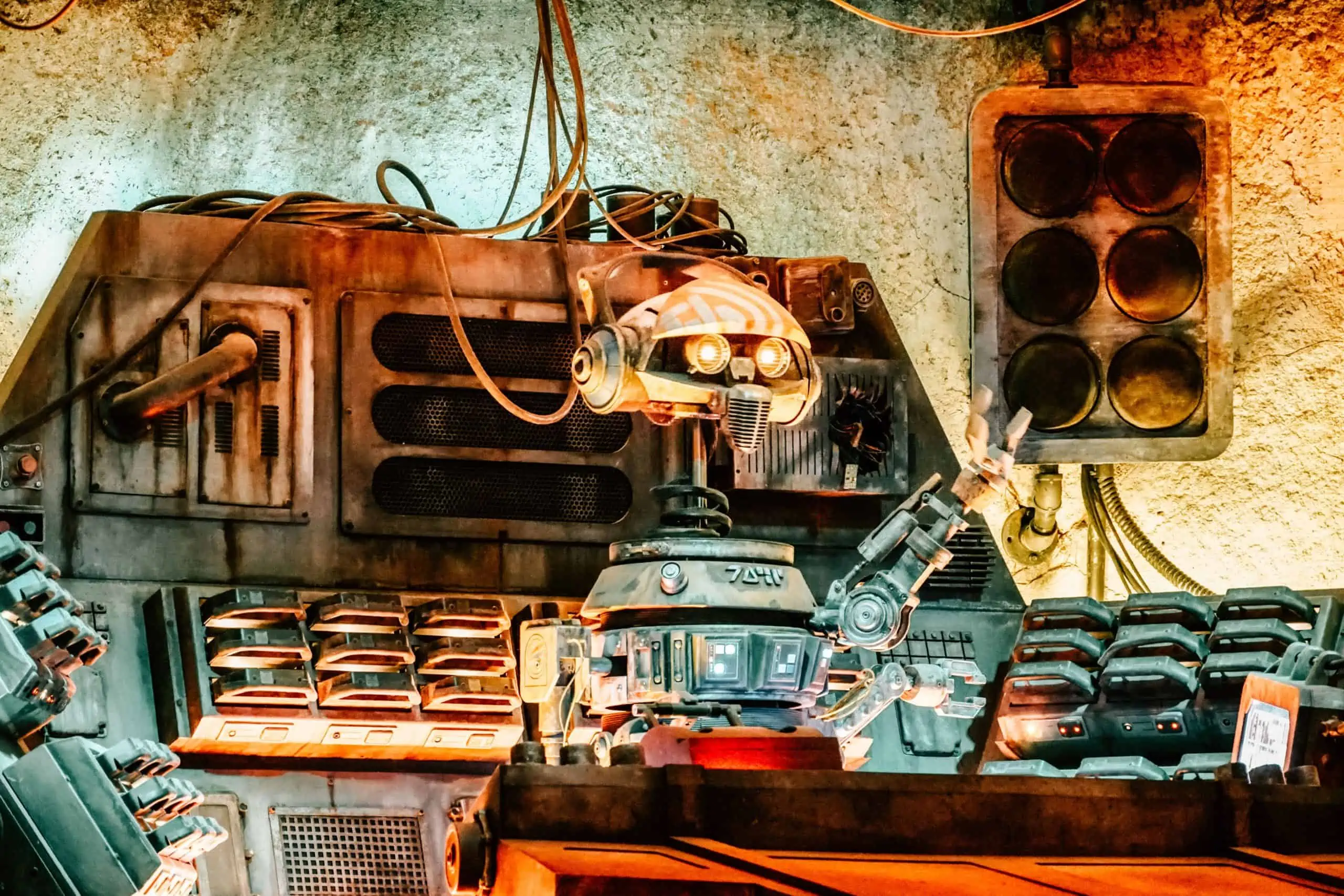1964 World’s Fair? More Like Walt’s Fair! What Every True Disney Fan Needs to Know about Walt, the World’s Fair, and the Birth of the Magic Kingdom
Have you ever wondered how the “World” was created? I’m talking about Disney World, of course! It’s a little more complicated – and a little more interesting – than just construction workers and cranes. The idea for Disney World came from Walt Disney himself – but it didn’t come about all at once. It had to grow and evolve from a tiny, mechanical bird, to life-size, life-like robots, to exhibits at a World’s Fair before becoming the Magic Kingdom we know and love today.
Walt’s Robots
Walt Disney was the Imagineer of Imagineers, and his creativity was at its peak performance in the 1960s. He was branching out beyond the world of filmmaking and into the realm of world-building, which for Walt, also meant constructing the world’s inhabitants.

Years were spent developing the mechanical, hydraulic, and aesthetic components of incredibly lifelike animals and human figures.1 In fact, the original inspiration had come to Walt in the 1940s while on a trip to France. He bought a toy bird in a cage that warbled and moved. Back in the States, he had his studio mechanics disassemble it to see how it worked.2 Though the little bird was sacrificed, worlds were born upon its wings.
Walt had much to take pride in, but he had a “special fondness” for the audio-animatronic work of WED Enterprises. Perhaps he felt a bit like Geppetto building so many Pinocchios. There was “Project Little Man” – the 9-inch tap-dancing man and the Jungle Cruise ride at Disneyland, populated with “wild” elephants, zebras, and crocodiles! These animatronics used cams and cables, but more sophisticated robotics soon emerged with pneumatic valves and hydraulic pressure to help them move.3 The Imagineers even engineered Duraflex “skin” that never cracked! (With those kinds of credentials, I’d like to see the Imagineers produce a line of skincare products for the masses!)
The pinnacle of the progressing audio-animatronics was Abraham Lincoln – called “winkin’ blinkin’ Lincoln” by some.4 It was also Walt’s tribute to the 16th president he had admired since he was a little boy.5 President Lincoln would greet his listeners by rising to his feet before addressing them about the importance of honoring American traditions and democracy. One day, Walt hoped to have an animatronic of every president for a Disneyland exhibit he planned to call One Nation Under God.6 But for now, Abraham Lincoln was an excellent start to the collection.

With his “Pinocchios” perfected, Walt deemed it time for them to go out into the world.
Walt’s Fair
Walt already had a world in mind – Disney World. “He envisioned not just an amusement park, but also a world of tomorrow that would give visitors a glimpse of what the future might look like,” and he wanted to build it in Florida.7 Which is why he called it “The Florida Project.” (Not his most creative moment, but Walt had a lot going on, and he eventually referred to it as “Disney World,” so cut him some slack, ok?)
The New York World’s Fair would provide both a testing ground and a showcase. “Walt…could experiment with new ride technologies for implementation at Disneyland utilizing generous corporate sponsorships, and he could test the waters for a new entertainment venue on the East Coast.”8 Although Walt was excited about his “Florida Project,” he was worried that East Coast audiences might not be as keen on the idea.9

The World’s Fair was being put together by Robert Moses, an influential New York urban planner and builder, as an exposition for American material and technological progress.10 It was like Moss had personally set the stage for Walt.
I can imagine Walt rushing to his Imagineers, waving a World’s Fair pamphlet in his hand, and exclaiming: “I want to go!!” All right, the proposal was probably more professional then, but it was described as “abrupt,” and the Imagineers were reportedly “shocked.”11 So, it could’ve happened that way! Professional or not, the plea was profuse, and you don’t say no to Walt Disney.
Walt’s plan to get into the World’s Fair was simple yet shrewd: offer to help the other companies who were already going to be there. He reasoned that these companies were investing a great deal to exhibit there, that they would want to stand out, but they wouldn’t know how to do it – and that’s where he’d come in.

Now, if you’ve been reading with us, then you already know what happened at the World’s Fair. If not, then – SPOILER ALERT! – Walt designed four attractions there:
- The General Electric Carousel of Progress, celebrating technology throughout the century
- Pepsi’s It’s a Small World After All – A Salute to UNICEF, which honored the world’s children.
- Ford’s Magic Skyway, which delighted visitors with time-traveling Ford Mustangs
- And last but not least, the Illinois Pavilion’s Great Moments with President Lincoln, which showcased “the most sophisticated Audio-Animatronic of its time.”12
Preparing for the World’s Fair pushed the Imagineers to expand and perfect audio-animatronics and rides, testing their ability to provide outstanding quality in significant quantities. Needless to say, their efforts were a great success! Each ride had its own story and unique theme, but one common factor was the audio-animatronics. Much of the new technology would be featured in Disneyland shortly after the Fair ended. It inspired Walt for yet another project – EPCOT, the Experimental Prototype Community of Tomorrow. (He was super pumped about that one!) But what about Walt’s dream of Disney World?
Well, he hadn’t forgotten it! The “…World’s Fair was, in essence, a successful test of an East Coast market for Disney themed entertainment and set the stage for the development of a ‘Florida Project.’”13 In other words, after the Fair, Walt knew his dream was ready to become a reality.

Walt was inspired by everything he saw, and the World’s Fair was no exception. It inspired him to dream bigger for his current park and even bigger for Disney World’s future. Walt seemed unstoppable.
Walt’s World
Disney began purchasing swampland around Orlando, Florida, spending five million dollars for 43 square miles – 150 times bigger than the area of Disneyland, California.14 This was done through proxy companies to keep the entire Disney World development a secret. However, the Aristocat got out of the bag, and land prices shot up in early 1965. Luckily, Disney had already purchased most of what they needed by then.15

(Photo: Florida Memory)
Disney World was progressing, but the man who imagined it was in decline. In early 1966, Walt was diagnosed with lung cancer due to his smoking habit and told he had between six months and two years to live. Marc Davis, a Disney animator, knew Walt was dying simply because, “He said, ‘Good-bye, Marc.’ He never said goodbye. It was always ‘see ya later.’”16
Even though it was Walt’s time to say goodbye to this world, his loved ones refused to say goodbye to his dream of Disney World. They banded together, broke ground, and opened the Magic Kingdom‘s doors on October 1, 1971. On opening day, Walt’s brother, Roy, announced the park’s new name – not “Florida Project” and not “Disney World” – but rather Walt Disney World, ensuring his brother and his brother’s legacy was forever remembered.17

(Photo: Florida Memory)
Not only was Disney World completed and renamed, but it also realized two of Walt’s other dreams within the park. The “Hall of Presidents” was an exciting exhibit from day one and continues to be, with each sitting president since the 1990s personally recording remarks for their audio-animatronic.18 EPCOT, though not as Walt envisioned it, opened in 1982 with World’s Fair-inspired Future World exhibits.19 I know Walt would be pleased, and I think he’d have a heck of a time exploring this world that the World’s Fair helped him to dream up.
Even though he never got to see it, Disney World wouldn’t exist without Walt. In a way, Disney World can be seen as an extension of Walt Disney himself. Everything he loved, everything that made Walt who he was, is there. His passion for technological progress is in every turn of the Carousel of Progress. His ingenuity and vivacity are in every magnetic pulse that propels the PeopleMover. His love of family and children rings out in every note played on It’s a Small World. His very values pour forth from the mouth of the great Abraham Lincoln.
As long as Disney World remains, a piece of Walt still resides in our world, too.
Cover Image
Photo: Unsplash
Recommended Gear for this Adventure
Disclaimer: We earn a commission if you click any of the links above and make a purchase at no additional cost to you.
Additional Resources in Print
Gitlin, Marty. Walt Disney : Entertainment Visionary. Essential Lives. Edina,
Minn: Abdo Publishing, 2010.
Watts, Steven. The Magic Kingdom : Walt Disney and the American Way of Life.
Columbia, MO: University of Missouri, 2001.















